SpringBoot整合Drools生成业务规则
xiaomifeng1010 人气:0最近的项目中,使用的是flowable工作流来处理业务流程,但是在业务规则的配置中,是在代码中直接固定写死的,领导说这样不好,需要规则可以动态变化,可以通过页面去动态配置改变,所以就花了几天时间去研究了一下Drools规则引擎框架。然后应用到了项目中。
首先在项目中引入规则引擎相关依赖
<properties>
<java.version>1.8</java.version>
<drools.version>7.20.0.Final</drools.version>
</properties>
<dependencies>
<!--引入规则引擎-->
<dependency>
<groupId>org.kie</groupId>
<artifactId>kie-spring</artifactId>
<version>${drools.version}</version>
<exclusions>
<exclusion>
<groupId>org.springframework</groupId>
<artifactId>spring-tx</artifactId>
</exclusion>
<exclusion>
<groupId>org.springframework</groupId>
<artifactId>spring-beans</artifactId>
</exclusion>
<exclusion>
<groupId>org.springframework</groupId>
<artifactId>spring-core</artifactId>
</exclusion>
<exclusion>
<groupId>org.springframework</groupId>
<artifactId>spring-context</artifactId>
</exclusion>
</exclusions>
</dependency>
<dependency>
<groupId>org.drools</groupId>
<artifactId>drools-compiler</artifactId>
<version>${drools.version}</version>
</dependency>
<dependency>
<groupId>org.projectlombok</groupId>
<artifactId>lombok</artifactId>
<scope>provided</scope>
<version>1.18.20</version>
</dependency>
</dependencies>
<build>
<resources>
<resource>
<directory>src/main/resources</directory>
<includes>
<include>**/*.*</include>
</includes>
</resource>
<resource>
<directory>src/main/java</directory>
<includes>
<include>**/*.xml</include>
</includes>
</resource>
</resources>
</build>
这里的drools版本使用的是7.20.0.Final,如果想和Flowable结合使用,在流程画图中插入规则任务,可以将drools版本和flowable starter中管理的drools版本 一致,比如我现在的项目中用到的

flowable-srping-boot-starter的依赖版本是6.5.0,点进去这个jar包的pom文件
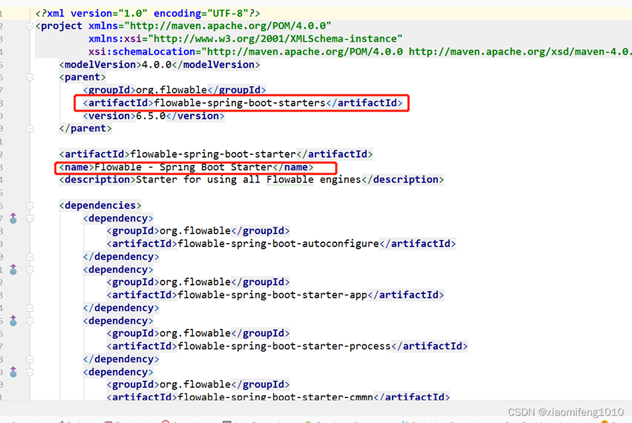
再进一步点parent标签
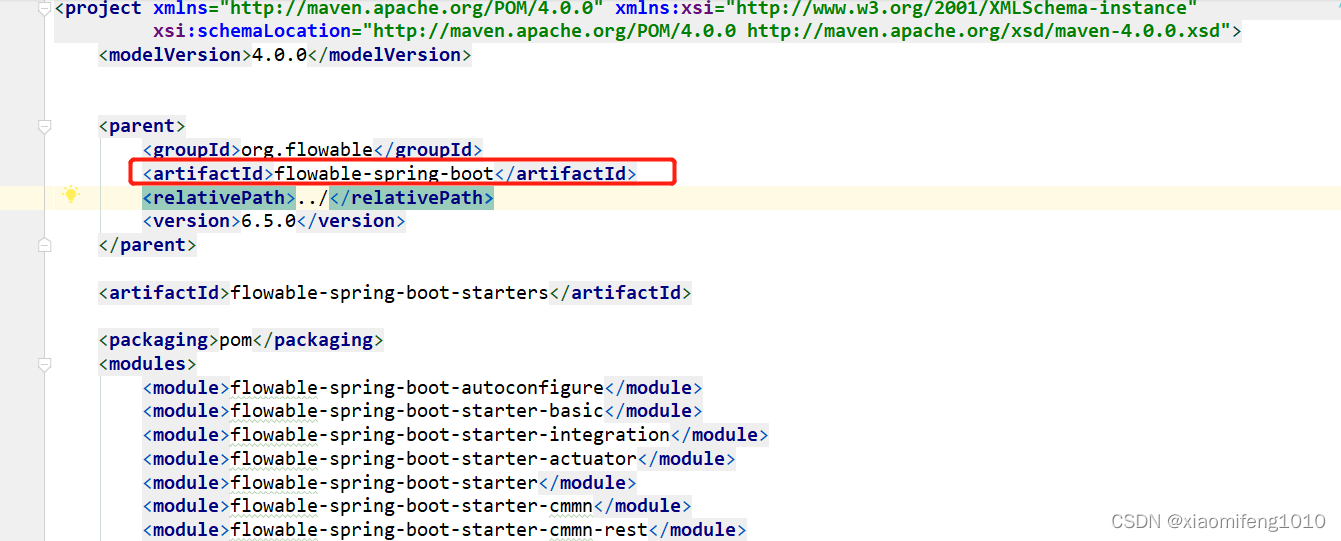
然后再点parent标签的依赖

然后再点parent标签内的flowable-root,然后搜索drools

可以看到flowable starter集成管理的drools版本是7.6.0-Final,所以最好和这个版本保持一致
当然你需要在flowable modeler画图项目中引入,然后启动flowable modeler程序,在画图界面
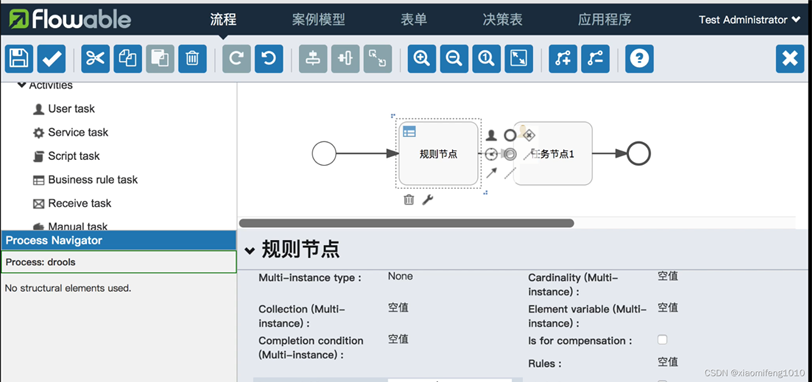
任务类型中就可以看到一个Business rule task,商业规则任务。
如果只是独立使用,则可以直接使用我最开始引入的那个版本7.20.0.Final
还有一个问题就是如果你的项目中引入了spring boot的热部署工具,

需要把这个依赖注释掉,项目中不能引入这个jar包,不然这个jar包会影响drools规则引擎执行生成的规则,而且在运行规则的时候也不会报错,这是个很隐蔽的坑,我在项目中已经踩过坑了,所以特别提示一下,就是这个jar包存在,规则引擎在触发执行规则的时候,是 不会执行的,在日志信息中一直显示的是执行规则0条,即使你的规则文件语法没有任何错误,直接将这个依赖删除后,就可以正常执行规则了。
引入相关依赖后,需要在项目中添加配置类:
在config包下创建DroolsAutoConfiguration类
import cn.hutool.core.util.CharsetUtil;
import lombok.extern.slf4j.Slf4j;
import org.kie.api.KieBase;
import org.kie.api.KieServices;
import org.kie.api.builder.*;
import org.kie.api.runtime.KieContainer;
import org.kie.api.runtime.KieSession;
import org.kie.internal.io.ResourceFactory;
import org.kie.spring.KModuleBeanFactoryPostProcessor;
import org.springframework.boot.autoconfigure.condition.ConditionalOnMissingBean;
import org.springframework.context.annotation.Bean;
import org.springframework.context.annotation.Configuration;
import org.springframework.core.io.Resource;
import org.springframework.core.io.support.PathMatchingResourcePatternResolver;
import org.springframework.core.io.support.ResourcePatternResolver;
import java.io.IOException;
/**
* @author xiaomifeng1010
* @version 1.0
* @date: 2021/12/6 9:30
* @Description drools配置类
*/
@Configuration
@Slf4j
public class DroolsAutoConfiguration {
public static final String RULE_PATH="rules/";
public KieServices getKieServices(){
KieServices kieServices = KieServices.Factory.get();
return kieServices;
}
/**
* 管理规则文件的位置路径信息
* @return
* @throws IOException
*/
@Bean
@ConditionalOnMissingBean(KieFileSystem.class)
public KieFileSystem kieFileSystem() throws IOException {
KieFileSystem kieFileSystem = getKieServices().newKieFileSystem();
for (Resource file:getRuleFiles()) {
kieFileSystem.write(ResourceFactory.newClassPathResource(RULE_PATH+file.getFilename(), CharsetUtil.UTF_8));
}
return kieFileSystem;
}
@Bean
@ConditionalOnMissingBean(KieContainer.class)
public KieContainer kieContainer() throws IOException {
KieServices kieServices = getKieServices();
KieRepository kieRepository = kieServices.getRepository();
kieRepository.addKieModule(new KieModule() {
@Override
public ReleaseId getReleaseId() {
return kieRepository.getDefaultReleaseId();
}
});
KieBuilder kieBuilder = kieServices.newKieBuilder(kieFileSystem());
kieBuilder.buildAll();
Results results = kieBuilder.getResults();
if (results.hasMessages(Message.Level.ERROR)){
log.error(results.getMessages().toString());
}
KieContainer kieContainer = kieServices.newKieContainer(kieRepository.getDefaultReleaseId());
return kieContainer;
}
@Bean
@ConditionalOnMissingBean(KieBase.class)
public KieBase kieBase() throws IOException {
KieBase kieBase = kieContainer().getKieBase();
return kieBase;
}
@Bean
@ConditionalOnMissingBean(KieSession.class)
public KieSession kieSession() throws IOException {
return kieContainer().newKieSession();
}
@Bean
@ConditionalOnMissingBean(KModuleBeanFactoryPostProcessor.class)
public KModuleBeanFactoryPostProcessor kModuleBeanFactoryPostProcessor(){
KModuleBeanFactoryPostProcessor kModuleBeanFactoryPostProcessor = new KModuleBeanFactoryPostProcessor();
return kModuleBeanFactoryPostProcessor;
}
/**
* 获取规则文件资源
* @return
* @throws IOException
*/
private Resource[] getRuleFiles() throws IOException {
ResourcePatternResolver resourcePatternResolver
=new PathMatchingResourcePatternResolver();
Resource[] resources = resourcePatternResolver.getResources("classpath*:" + RULE_PATH + "**/*.*");
return resources;
}
}
然后在项目的resources下创建rules文件夹存放规则文件
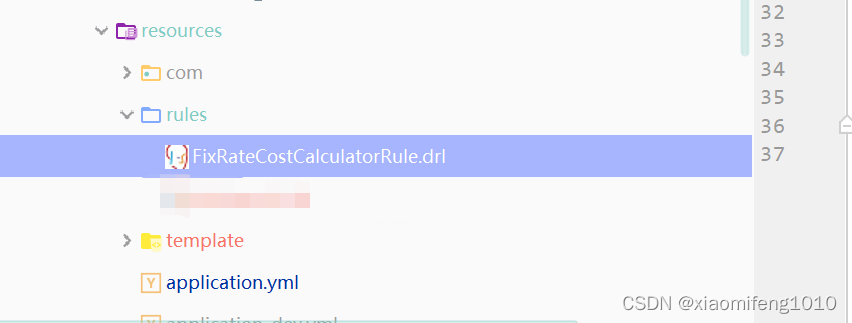
创建一个drl后缀的规则文件FixRateCostCalculatorRule.drl
//package 可以随意指定,没有具体的要求,可以命名成和项目相关的,或者直接rules
package com.drools
//或者这样
//package rules
import java.math.BigDecimal
import java.lang.Integer
import org.apache.commons.lang3.math.NumberUtils;
import com.drools.bo.GuatanteeCost
//这里设置的全局变量只相当于声明变量,需要在代码执行规则前给该变量赋值初始化
global org.slf4j.Logger logger
rule "rule1"
//dialect "java"
salience 30
//防止死循环
//no-loop true
enabled false
when
$guaranteeCost:GuatanteeCost(amount>NumberUtils.DOUBLE_ZERO && amount<=300000)
then
$guaranteeCost.setCost(200d);
logger.info("保费"+200);
update($guaranteeCost)
end
rule "rule2"
enabled false
salience 20
when
$guaranteeCost:GuatanteeCost(amount>300000,amount<=500000)
then
$guaranteeCost.setCost(300d);
logger.info("保费"+300);
update($guaranteeCost)
end
rule "rule3"
enabled false
salience 10
when
$guaranteeCost:GuatanteeCost(amount>500000,amount<=800000)
then
// 效果和上边两条范围中的更新数据效果一样
modify($guaranteeCost){
setCost(400d)
}
logger.info("保费"+400);
end
然后需要创建一个java对象GuatanteeCost,用于向规则文件中传递Fact(java对象)变量值
amount是GuatanteeCost类中的属性
@Data
@NoArgsConstructor
@AllArgsConstructor
public class GuatanteeCost {
/**
* 保证金金额
*/
private Double amount;
/**
* 保费金额
*/
private Double cost;
}
然后就可以写一个单元测试方法,或者创建一个controller进行测试
import cn.hutool.core.util.CharsetUtil;
import com.baomidou.mybatisplus.core.toolkit.Wrappers;
import com.drools.bo.GuatanteeCost;
import com.drools.entity.DroolsRuleConfig;
import com.drools.service.DroolsRuleConfigService;
import com.github.xiaoymin.knife4j.annotations.ApiSort;
import io.swagger.annotations.Api;
import io.swagger.annotations.ApiImplicitParam;
import io.swagger.annotations.ApiOperation;
import lombok.AllArgsConstructor;
import lombok.extern.slf4j.Slf4j;
import org.apache.commons.lang3.StringUtils;
import org.drools.template.ObjectDataCompiler;
import org.kie.api.io.ResourceType;
import org.kie.api.runtime.KieSession;
import org.kie.internal.io.ResourceFactory;
import org.kie.internal.utils.KieHelper;
import org.springframework.beans.factory.annotation.Autowired;
import org.springframework.web.bind.annotation.PostMapping;
import org.springframework.web.bind.annotation.RequestMapping;
import org.springframework.web.bind.annotation.RestController;
import java.io.IOException;
import java.io.InputStream;
import java.math.BigDecimal;
import java.util.List;
/**
* @author xiaomifeng1010
* @version 1.0
* @date: 2021/12/6 15:41
* @Description
*/
@RestController
@RequestMapping("/drools")
@AllArgsConstructor(onConstructor_={@Autowired})
@Api(tags = "drools规则引擎测试接口")
@ApiSort(30)
@Slf4j
public class DroolsTestController {
@Autowired
private KieSession kieSession;
@Autowired
private DroolsRuleConfigService droolsRuleConfigService;
@ApiOperation("测试计算保费规则")
@ApiImplicitParam(name="bzjAmount",value = "保证金金额(单位元)")
@PostMapping("test/rule")
public String testDrools(BigDecimal bzjAmount){
GuatanteeCost guatanteeCost = new GuatanteeCost();
guatanteeCost.setAmount(bzjAmount.doubleValue());
kieSession.insert(guatanteeCost);
kieSession.setGlobal("logger",log);
int allRules = kieSession.fireAllRules();
Double cost = guatanteeCost.getCost();
log.info("成功执行{}条规则",allRules);
log.info("计算保费{}元", cost);
kieSession.dispose();
return cost+"";
}
@ApiOperation("测试使用规则模板计算保费规则")
@ApiImplicitParam(name="bzjAmount",value = "保证金金额(单位元)")
@PostMapping("test/ruleTemplate")
public String testDroolsRuleTemplate(BigDecimal bzjAmount){
GuatanteeCost guatanteeCost = new GuatanteeCost();
guatanteeCost.setAmount(bzjAmount.doubleValue());
List<DroolsRuleConfig> droolsRuleConfigList = droolsRuleConfigService.list(Wrappers.<DroolsRuleConfig>lambdaQuery()
.eq(DroolsRuleConfig::getRuleName, "fix"));
ObjectDataCompiler converter = new ObjectDataCompiler();
String drlContent = StringUtils.EMPTY;
try(InputStream dis= ResourceFactory.
newClassPathResource("rules/FixRateCostCalculatorRule.drt", CharsetUtil.UTF_8)
.getInputStream()){
// 填充模板内容
drlContent=converter.compile(droolsRuleConfigList, dis);
log.info("生成的规则内容:{}",drlContent);
}catch (IOException e) {
log.error("获取规则模板文件出错:{}",e.getMessage());
}
KieHelper helper = new KieHelper();
helper.addContent(drlContent, ResourceType.DRL);
KieSession ks = helper.build().newKieSession();
ks.insert(guatanteeCost);
// kieSession.setGlobal("logger",log);
int allRules = ks.fireAllRules();
Double cost = guatanteeCost.getCost();
log.info("成功执行{}条规则",allRules);
log.info("计算保费{}元", cost);
kieSession.dispose();
return cost+"";
}
}

至此,可以先忽视第二个接口方法,使用第一个接口方法来测试规则的运行

计算的费用是200,执行的是rule1规则,200000介于0-300000之间,所以保费计算的是200
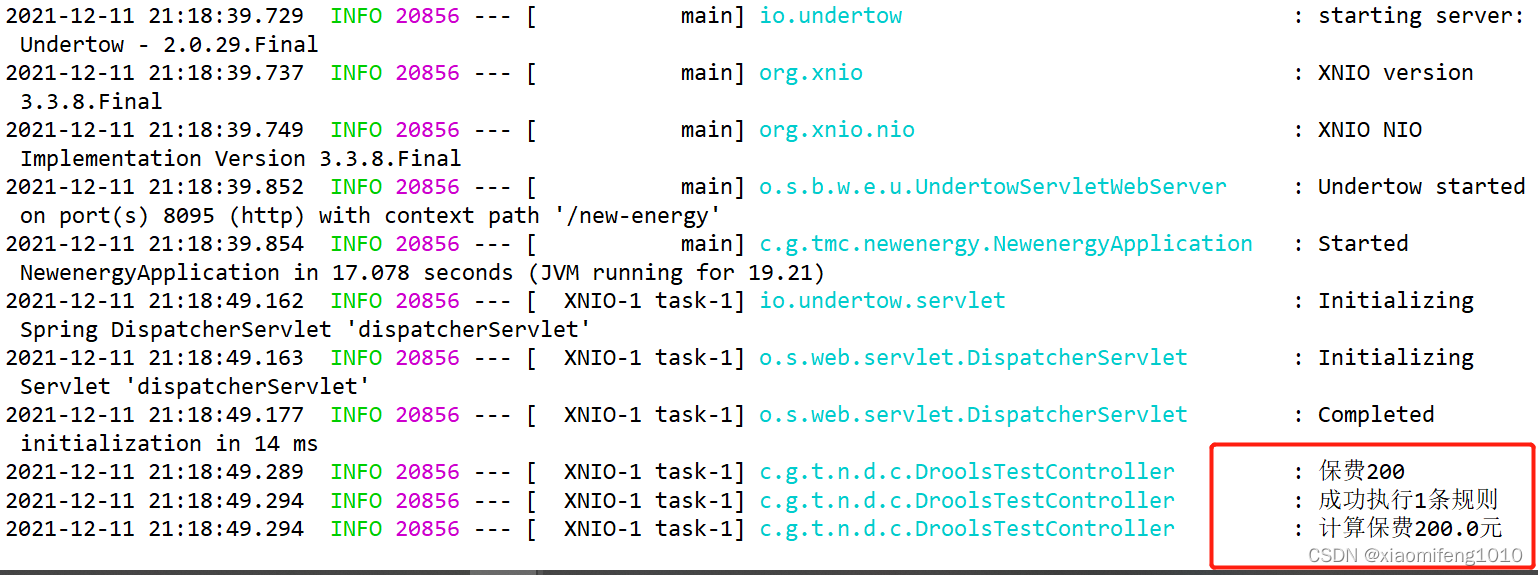
这种直接写drl规则文件,在里边设定规则的方式比较简便,但是却不灵活,如果我想再添加几条范围,那么就需要重新再来修改这个drl文件,所以在项目中可以使用规则模板drt
然后在项目resources的rules目录下再创建一个drt文件FixRateCostCalculatorRule.drt
//模板文件
template header
min
max
fixedFee
package drools.templates
import com.drools.bo.GuatanteeCost
template "fixRate"
rule "calculate rule_@{row.rowNumber}"
dialect "mvel"
no-loop true
when
$guaranteeCost:GuatanteeCost(amount>@{min} && amount<=@{max})
then
modify($guaranteeCost){
setCost(@{fixedFee})
}
end
end template
然后创建一个表,用于保存min,max和fixed的参数值(注意事项:template header下边的min,max和fixedFee都相当于声明的参数,但是不能在min上边加一行注释如://参数说明,在解析规则模板时候会把“//参数说明”也当做声明的参数变量),因为这些值可以动态变化了,所以范围规则也相当于可以动态变化,范围就不是之前设置的固定的啦

创建这样一个表,这样就可以灵活配置范围和保费金额了
CREATE TABLE `biz_drools_rule_config` ( `id` bigint(20) NOT NULL, `rule_code` varchar(255) DEFAULT NULL COMMENT '规则编码', `rule_name` varchar(255) DEFAULT NULL COMMENT '规则名称', `min` int(10) DEFAULT NULL COMMENT '保证金范围最小值', `max` int(10) DEFAULT NULL COMMENT '保证金范围最大值', `fixed_fee` decimal(10,2) DEFAULT NULL COMMENT '固定保费', `fee_rate` decimal(5,3) DEFAULT NULL COMMENT '费率(小数)', `create_by` varchar(25) DEFAULT NULL, `create_time` datetime DEFAULT NULL, `update_by` varchar(25) DEFAULT NULL, `update_time` datetime DEFAULT NULL, PRIMARY KEY (`id`) USING BTREE ) ENGINE=InnoDB DEFAULT CHARSET=utf8mb4 ROW_FORMAT=DYNAMIC;
然后创建对应的实体类,mapper和service,可以使用项目中的代码生成器快捷生成或者idea的插件生成
然后就可以使用controller中的第二个接口方法来测试了
数据库中的数据插入,可以在项目页面中写一个用于添加规则配置参数的页面,在里边插入几条数

这里我是先随意手动添加了几条数据
然后在knife4j文档页面执行接口测试
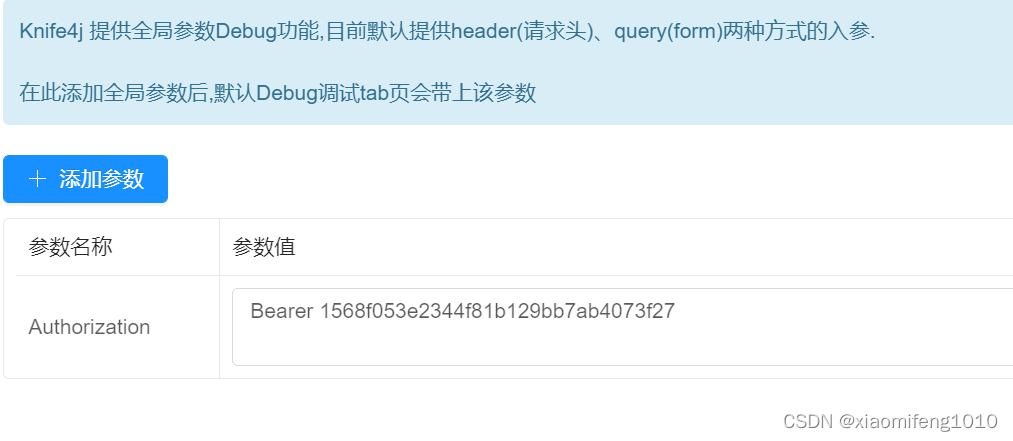
加上oauth2的验证信息

输入amount的值,也计算的固定保费200
同时从数据库中查询出来3条数据,对应三个范围,生成了三个规则(rule),可以从项目日志中查看


此时可以把数据库中的最大最小值改变一下,再测试一下

此时再传入一个保证金amount值20万,就会计算出保费费用是300元 ,执行代码时,会再次生成新的规则,每次执行规则模板动态生成的规则drl内容实际上保存在内存中的,并不像最开始创建的drl文件那样
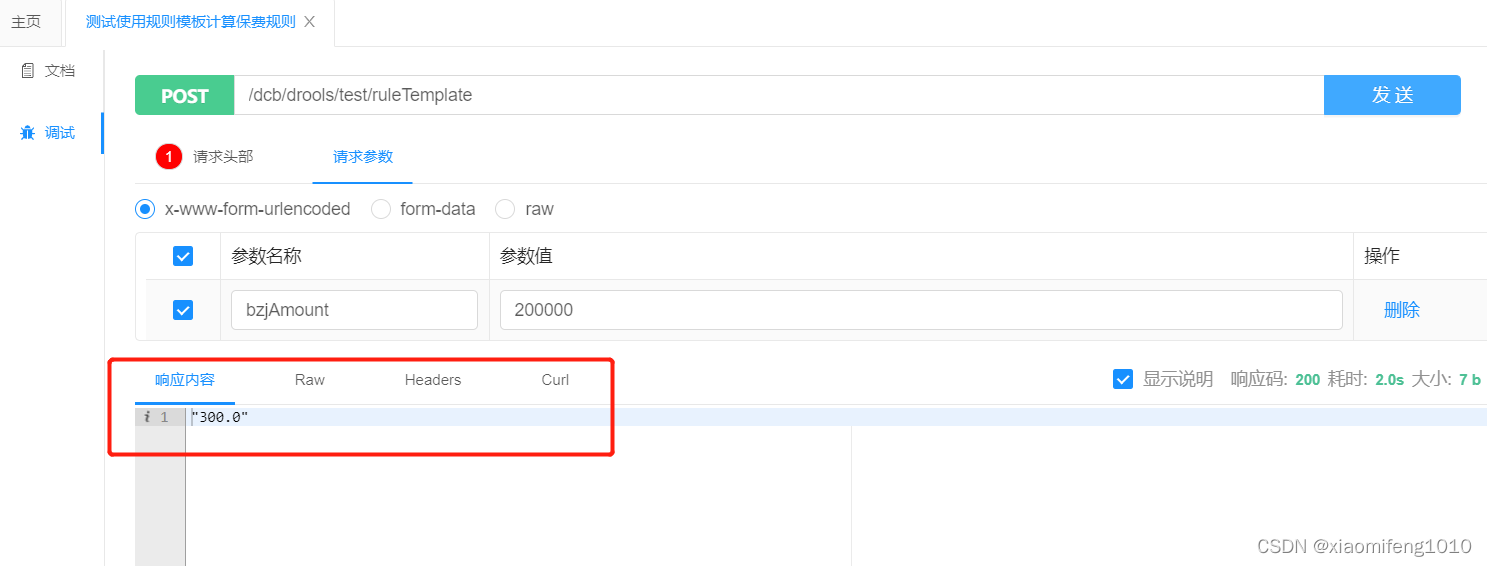
再次执行,就会发现保费计算就成了300元

同时规则模板动态生成的规则内容也对应发生了变化

为了方便使用这个规则模板,可以将测试规则模板的这个接口方法封装成一个辅助类,在业务使用时,可以直接调用
package com.drools.util;
import cn.hutool.core.util.CharsetUtil;
import com.baomidou.mybatisplus.core.toolkit.Wrappers;
import com.drools.bo.GuatanteeCost;
import com.drools.entity.DroolsRuleConfig;
import com.drools.service.DroolsRuleConfigService;
import lombok.extern.slf4j.Slf4j;
import org.apache.commons.lang3.StringUtils;
import org.drools.template.ObjectDataCompiler;
import org.kie.api.io.ResourceType;
import org.kie.api.runtime.KieSession;
import org.kie.internal.io.ResourceFactory;
import org.kie.internal.utils.KieHelper;
import org.springframework.beans.factory.annotation.Autowired;
import org.springframework.stereotype.Component;
import java.io.IOException;
import java.io.InputStream;
import java.math.BigDecimal;
import java.util.List;
/**
* @author xiaomifeng1010
* @version 1.0
* @date: 2021/12/8 16:22
* @Description 根据规则引擎模板获取保费金额
*/
@Component
@Slf4j
public class CalculateCostUtil {
@Autowired
private DroolsRuleConfigService droolsRuleConfigService;
/**
* @description: 获取固定保费
* @author: xiaomifeng1010
* @date: 2021/12/8
* @param bzjAmount
* @return: BigDecimal
**/
public BigDecimal getFixedFee(BigDecimal bzjAmount){
GuatanteeCost guatanteeCost = new GuatanteeCost();
guatanteeCost.setAmount(bzjAmount.doubleValue());
List<DroolsRuleConfig> droolsRuleConfigList = droolsRuleConfigService.list(Wrappers.<DroolsRuleConfig>lambdaQuery()
.eq(DroolsRuleConfig::getRuleName, "fix"));
ObjectDataCompiler converter = new ObjectDataCompiler();
String drlContent = StringUtils.EMPTY;
try(InputStream dis= ResourceFactory.
newClassPathResource("rules/FixRateCostCalculatorRule.drt", CharsetUtil.UTF_8)
.getInputStream()){
// 填充模板内容
drlContent=converter.compile(droolsRuleConfigList, dis);
log.info("生成的规则内容:{}",drlContent);
}catch (IOException e) {
log.error("获取规则模板文件出错:{}",e.getMessage());
}
KieHelper helper = new KieHelper();
helper.addContent(drlContent, ResourceType.DRL);
KieSession ks = helper.build().newKieSession();
ks.insert(guatanteeCost);
int allRules = ks.fireAllRules();
Double cost = guatanteeCost.getCost();
log.info("成功执行{}条规则",allRules);
log.info("计算保费{}元", cost);
ks.dispose();
return BigDecimal.valueOf(cost);
}
}
暂时就研究了这些点东西,算是刚刚入门这个框架,买的drools图书,还得再多读几遍,多实践操作一下,以后再做一些更深入的总结
加载全部内容